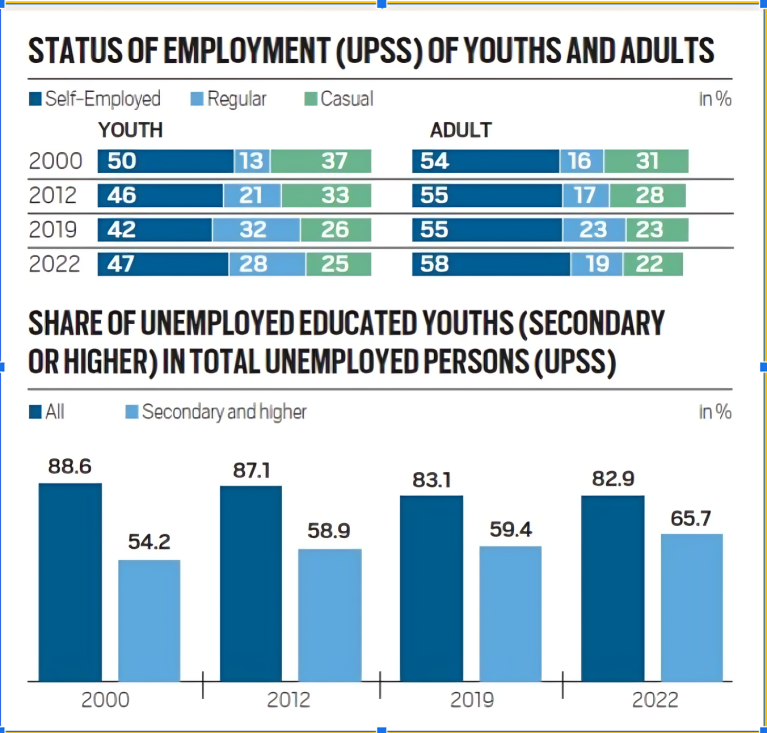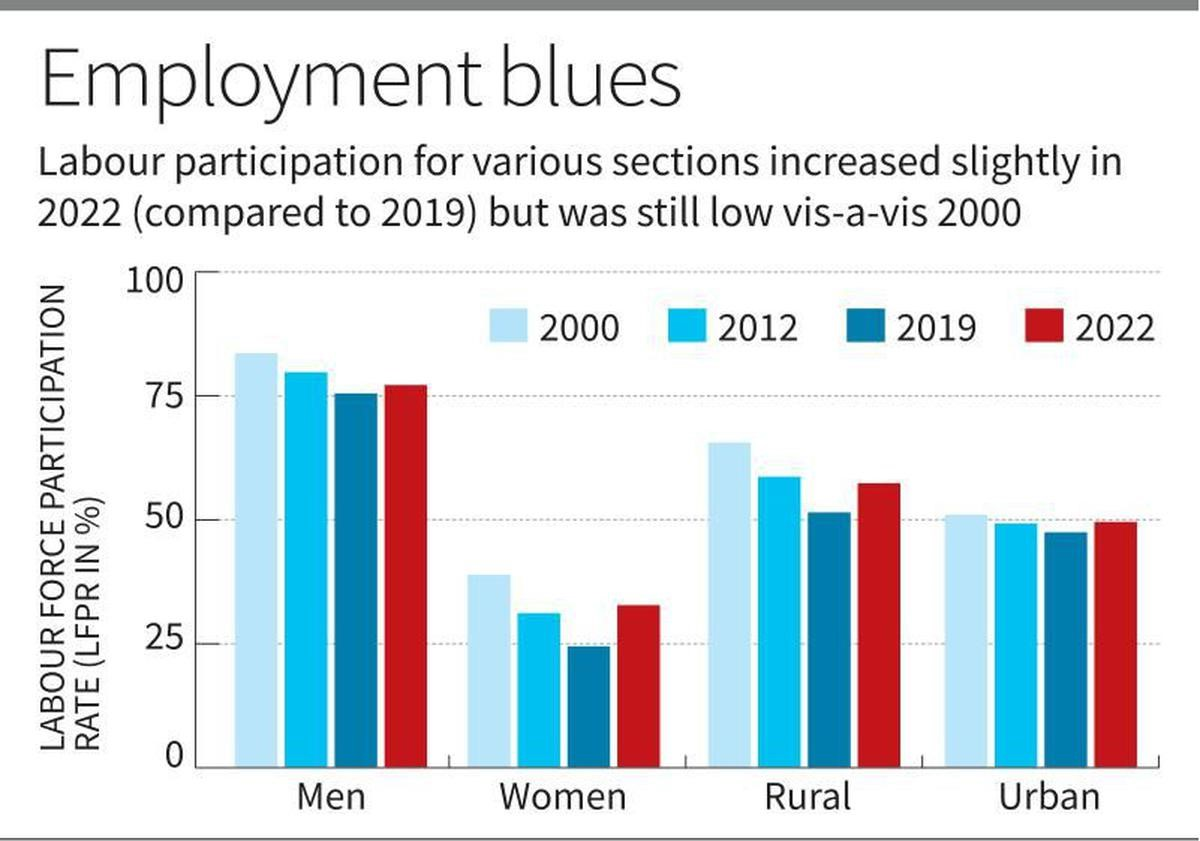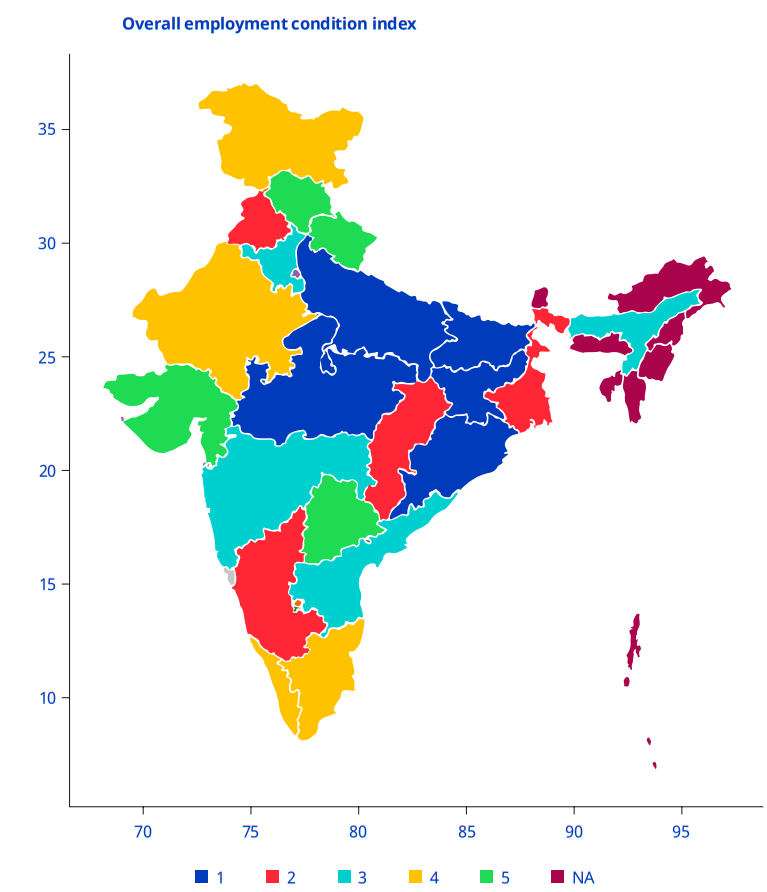India Employment Report 2024: ILO | 29 Mar 2024
For Prelims: India Employment Report 2024: ILO, Unemployment rates, Institute for Human Development (IHD), International Labour Organisation (ILO), Labour Force Participation Rate (LFPR), Worker Population Ratio (WPR), Unemployment Rate (UR).
For Mains: India Employment Report 2024: ILO, Major Issues Related to Unemployment in India.
Why in News?
Recently, the Institute for Human Development (IHD) and International Labour Organisation (ILO) have released a report titled- ‘India Employment Report 2024’, which highlights that India’s youth continue to grapple with soaring Unemployment rates.
- The Institute for Human Development (IHD) was established in the year 1998 under the aegis of the Indian Society of Labour Economics (ISLE), it is a non-profit autonomous institution that aims to contribute towards building a society that fosters and values an inclusive social, economic and political system that is free from poverty and deprivations.
Note
The India Employment Report 2024 is the third in the series of regular publications by the IHD on labour and employment issues. This report on Youth Employment, Education and Skills examines the challenge of youth employment in the context of the emerging economic, labour market, educational and skills scenario in India and changes over the past two decades.
- The report is primarily based on analysis of data from the National Sample Surveys and the Periodic Labour Force Surveys between 2000 and 2022, with a postscript for 2023.
What are the Key Highlights of the Report?
- Poor Employment Conditions:
- Despite improvements in overall labour force participation and employment rates, employment conditions in India remain poor, with issues such as stagnant or declining wages, increased self-employment among women, and a higher proportion of unpaid family work among youth.
- India’s youth account for almost 83% of the unemployed workforce and the share of youngsters with secondary or higher education in the total unemployed has almost doubled from 35.2% in 2000 to 65.7% in 2022.
- Youth Employment Challenges:
- Youth employment and underemployment surged between 2000 and 2019, with educated youths experiencing significantly higher levels of joblessness.
- The Labour Force Participation Rate (LFPR), Worker Population Ratio (WPR) and the Unemployment Rate (UR) showed a long-term deterioration between 2000 and 2018 but witnessed an improvement after 2019.
- The improvement coincides with periods of economic distress, both pre and post-Covid-19 with the exception of two peak Covid-19 quarters.
- Paradoxical Improvements:
- Over the past two decades, India's job market has seen some improvements in certain labour indicators, but the overall employment situation remains challenging.
- Non-farm sectors have not grown sufficiently to absorb workers from agriculture, despite non-farm employment growing faster than farm employment before 2018.
- Most workers, around 90%, are engaged in informal work, and the proportion of regular employment, which was steadily increasing after 2000, started declining after 2018.
- India's large young workforce, often seen as a demographic advantage, faces challenges due to a lack of necessary skills.
- A significant portion of youth lacks basic digital literacy skills, with 75% unable to send emails with attachments, 60% unable to copy and paste files, and 90% unable to perform basic spreadsheet tasks like putting a mathematical formula.
- Wages and Earnings are Declining:
- While wages of casual labourers maintained a modest upward trend during 2012–22, real wages of regular workers either remained stagnant or declined. Self Employed real earnings also declined after 2019.
- Overall, wages have remained low. As much as 62% of the unskilled casual agricultural workers and 70% of such workers in the construction sector at the all-India level did not receive the prescribed daily minimum wages in 2022.
- Changing the Structure of Industrial Employment:
- There has been a rapid introduction of digitally mediated gig and platform work, which are algorithmically controlled by the platforms and have brought about new features in control of the labour process.
- Increasingly, platform and gig work have been expanding, but it is, to a large extent, the extension of informal work, with hardly any social security provisions.
- Migration is Likely to Increase in Future:
- The rates of urbanization and migration are expected to considerably increase in the future.
- India is expected to have a migration rate of around 40% in 2030 and will have an urban population of around 607 million.
- The bulk of this increase in urban growth will come from migration. The pattern of migration also shows regional imbalance in the labour markets.
- The direction of migration in general is from eastern, north-eastern and central regions to southern, western and northern regions.
- Regional Disparities:
- Significant variations in employment outcomes exist across states, with certain states consistently ranking lower in employment indicators.
- States like Bihar, Uttar Pradesh, Odisha, Madhya Pradesh, Jharkhand, and Chhattisgarh have struggled with poor employment outcomes over the years, reflecting the influence of regional policies.
- Widening Gender Gap:
- India is facing the challenge of a substantial gender gap in the labour market, with low rates of female labour force participation.
- The unemployment challenge among young women, especially those who are highly educated, is enormous.
- Social inequalities also persist despite affirmative action and targeted policies, with Scheduled Castes and Scheduled Tribes facing barriers to accessing better job opportunities.
- Although educational attainment has improved across all groups, social hierarchies persist, exacerbating the employment disparity.
- Policy Recommendations:
- To enhance production and foster growth with a focus on employment, policy recommendations are proposed:
- Integrate an employment creation agenda into macroeconomic policies, particularly emphasising productive non-farm employment, notably in manufacturing.
- Prioritise labour-intensive manufacturing to absorb unskilled labour and complement with selected services.
- Concentrate efforts on supporting micro, small, and medium-sized enterprises through a decentralised approach.
- Increase agricultural productivity, generate non-farm employment opportunities, and encourage entrepreneurship.
- Invest in green and blue economies, leveraging strategic investments, capacity-building initiatives, and policy frameworks to unlock substantial employment potential.
- To enhance job quality, strategies are recommended:
- There's a need to invest in and regulate sectors such as the care industry and the digital economy, which are anticipated to be significant sources of employment for young people.
- Fostering an inclusive urbanisation and migration policy is essential, particularly given India's projected rise in urbanisation and migration rates, driven by youths seeking decent employment opportunities, predominantly in urban areas.
- Ensuring a robust supportive role for labour policy and regulation is crucial. This involves guaranteeing a minimum standard of employment quality and safeguarding basic rights for workers across all sectors.
- To address labour market inequalities, key approaches are suggested:
- Implement policies to enhance women's participation in quality employment.
- Integrate high-quality skills training into education to uplift economically disadvantaged groups and boost employability.
- Iimprove access to information technology and bridge the digital gap. Establish a fair labour market by combating discrimination against women and marginalised communities.
- To enhance production and foster growth with a focus on employment, policy recommendations are proposed:
What are the Government’s Initiatives Related to Employment?
- Support for Marginalised Individuals for Livelihood and Enterprise (SMILE)
- PM-DAKSH (Pradhan Mantri Dakshta Aur Kushalta Sampann Hitgrahi)
- Mahatma Gandhi National Rural Employment Guarantee Act (MGNREGA)
- Pradhan Mantri Kaushal Vikas Yojana (PMKVY)
- Start Up India Scheme
- Rozgar Mela
- Indira Gandhi Urban Employment Guarantee Scheme- Rajasthan.
What is the International Labor Organization?
- It is the only tripartite United Nations (UN) agency. It brings together governments, employers and workers of 187 Member States (India is a member), to set labour standards, develop policies and devise programmes promoting decent work for all women and men.
- It received the Nobel Peace Prize in 1969.
- It was established in 1919 by the Treaty of Versailles as an affiliated agency of the League of Nations and became the first affiliated specialised agency of the UN in 1946.
- Headquarters: Geneva, Switzerland
Read more: NFHS-5 National Report, Household Consumption Expenditure Survey 2022-23
UPSC Civil Services Examination, Previous Year Questions (PYQs)
Prelims
Q. Disguised unemployment generally means (2013)
(a) large number of people remain unemployed
(b) alternative employment is not available
(c) marginal productivity of labour is zero
(d) productivity of workers is low
Ans: (c)
Mains
Q. Most of the unemployment in India is structural in nature. Examine the methodology adopted to compute unemployment in the country and suggest improvements. (2023)



